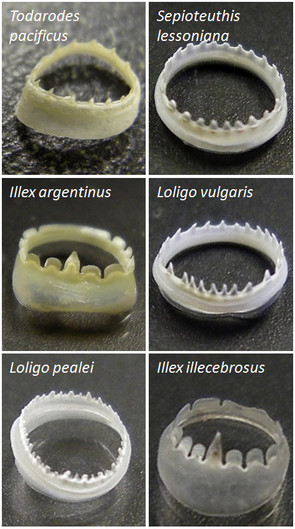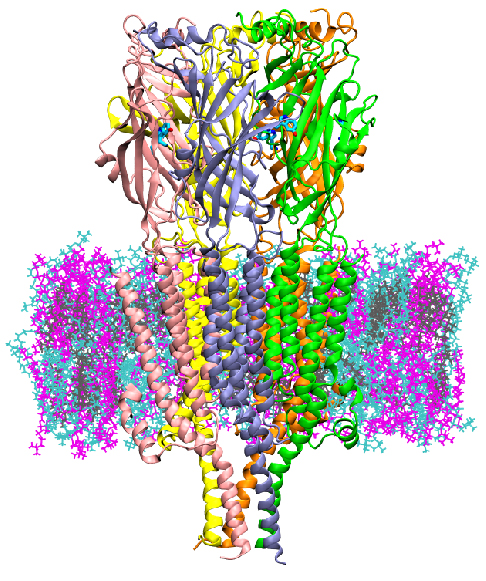News Story
Tunable Thermal 'Switch' Discovered in Squid-based Biomaterials

Image provided by Melik Demirel Lab @ Penn State.
A collaborative research team of materials scientists and mechanical engineers has invented a "switching effect" for thermal conductivity and mechanical properties that can be incorporated into the fabrication of materials including textiles and garments. Using heat transport principles combined with a segmented copolymer morphology inspired by squid ring teeth, the team designed a fabric that can regulate its thermal properties – switching back and forth between insulating and cooling – based on the amount of water that is present.
"The beauty and unique power of neutron scattering helped us solve the puzzle of how tandem protein repeat units really influence the observed thermal conductivity in hydrated samples, as heavy water simply becomes ‘invisible’ to neutrons - we found that the increased and ‘altered’ dynamics of amorphous strands were, actually, responsible for this increased thermal conductivity in hydrated samples," said Madhusudan Tyagi, an associate research scientist in UMD’s Department of Materials Science and Engineering and co-author on the study. "I believe this research is going to change how we engineer thermal properties of soft matter, particularly proteins and polymers, especially using neutrons as typically hard condensed matter is where most of the work is done in this regard."
The garments made using this technology will be a step above what is available on the market today because of the materials’ extremely wide range of technical capabilities, which can accommodate the whole gamut of athletic scenarios in one garment. Fleece, by way of comparison, is "breathable," but this biopolymer material actively conducts heat out of the garment, useful especially for professional athletes.
"The biopolymer has a low thermal conductivity while dry, essentially storing body heat and keeping the user warm while not active," said John Tomko, a Ph.D. candidate in the University of Virginia’s Department of Materials Science and Engineering, and lead author on the research paper published this week in Nature Nanotechnology. "As soon as the wearer begins to sweat, the material will become hydrated and instantly increase its thermal conductivity, allowing this body heat to escape through the material and cool the user down. When the person is done training and the sweat has evaporated, the material goes back to an insulative state and keeps the user warm again."
The process of creating tunable materials could be good news for manufacturers as well as the environment. In general, textile companies rely on different types of fibers and manufacturing processes to create clothing with varying attributes, but the tunable aspect of these new materials means that insulating and cooling attributes can be created from the same process, ultimately leading to lower manufacturing costs and reduced carbon emissions.
Squid ring teeth, which make tunable materials possible, are inspiring new avenues of scientific research. These biomaterials contain unique properties such as strength, self-healing and biocompatibility, making them suitable for programming at the molecular level. The teeth can be extracted from the suction cups of squids, or be synthetically produced via recombinant expression in bacteria - both sustainable resources. In a 2016 study published at Proceedings of National Academy of Sciences, it was discovered that tandem repeats morphology can be controlled in squid ring teeth proteins; hence, tunable synthetic proteins mimicking squid ring teeth, patterned on tandem repeating sequences, were designed.
"Controlling thermal transport in modern technologies – refrigeration, data storage, electronics or textiles – is an unsolved problem," said Melik Demirel, a professor in the Department of Engineering Science and Mechanics at Penn State, and co-author on the paper. "Most standard plastic materials, for example, have very low thermal conductivity and they are thermal insulators. These squid-based bio-materials that we are working on have low conductivity at ambient humidity, but they can be engineered so that their thermal conductivity increases dramatically."
Additional collaborators on this study include Abdon Pena-Francesch, a von Humboldt Fellow at the Max Planck Institute in Stuttgart, Germany; Huihun Jung, a doctoral candidate in the Dept of Engineering Science and Mechanics at Penn State; Benjamin D. Allen, assistant research professor of biochemistry and molecular biology at Penn State, and Patrick E. Hopkins (PI), professor of mechanical & aerospace engineering and materials science & engineering at the University of Virginia.
Related media:
University of VA Multidisciplinary Engineering Team Designs New Technology for Smart Materials - UVA, 15Aug2018
Thermal switch discovered in engineered squid-based biomaterials - Penn State, 13Aug2018
Published August 17, 2018














